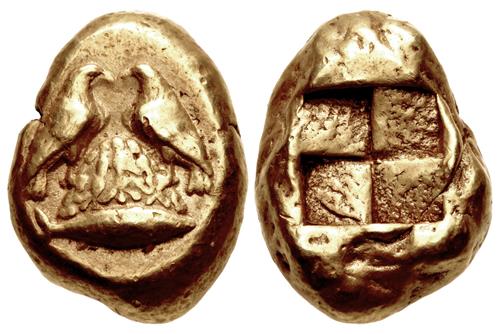
|
MYSIA, Kyzikos. Circa 450-330 BC. EL Stater (15.5mm, 16.01 g).
Triton XXIV
Lot: 636. Estimated: $ 7 500
Greek, Coin-in-Hand Video, Electrum
Sold For $ 12 000. This amount does not include the buyer’s fee.
Go to Live
|
|
MYSIA, Kyzikos. Circa 450-330 BC. EL Stater (15.5mm, 16.01 g). Two eagles standing facing each other on ornamented omphalos; below, tunny right / Quadripartite incuse square. Von Fritze I 220; Greenwell 22; Boston MFA 1535 = Warren 1440; SNG BN 348; BMC 100; Gulbenkian 1423. Lightly toned. Good VF. Rare.
From the Jonathan P. Rosen Collection. Ex Numismatica Ars Classica 92 (23 May 2016), lot 192.
This rare type depicts the legend of the omphalos (navel) stone, which marked the sacred precinct of the sanctuary of Apollo at Delphi as the physical center of the earth. According to tradition, two eagles, which had been released by Zeus, one flying from the east, and the other from the west, met exactly at the site of Apollo’s sanctuary. This spot was marked for all to see by the stone omphalos, and designated as the center of the earth. The omphalos was a white stone ornamented with stripes of various kinds, and upon it were the representations of the two eagles (as seen on this coin type – the tunny fish below is the city-badge of Kyzikos). This scene was frequently represented in vase-paintings, but is extremely rare on coinage. The omphalos probably stood on the sacred hearth that was in the center of the temple.
The origins of Apollo’s temple at Delphi are described in the Homeric Hymn to Apollo. Apollo descended from Mt. Olympos and made his way through northern and central Greece until he finally found the proper site for the foundation of his oracle at Crisa under the snow-capped Mt. Parnassos. He laid out his temple and then slew a she-dragon which inhabited the area. The name of the site was subsequently called Pytho (and Apollo, the Pythian) due to the rotting body of the slain dragon. (The verb πύθειν, in Greek, means ‘to rot’.) Interestingly enough, Zeus punished Apollo for the murder of the dragon by exiling him to Thessaly for nine years. A religious festival called the Stepteria was celebrated every ninth year at Delphi to commemorate these events associated with the foundation myth of the sanctuary.
After Apollo established his sanctuary, he went about the business of recruiting attendants for the temple. He noticed a ship passing by, manned by Cretans from Knossos, and on their way to Pylos. Apollo transformed himself into a dolphin (ἡ δελφίς, hence the name of the city) and leaped aboard the Cretan ship. At first the men tried to throw the dolphin back into the sea, but they were “awed” by it into a “fearful submission.” After a lengthy voyage, Apollo led the ship to Crisa, where “he leaped ashore and revealed himself as a god amid a blaze of fiery brightness and splendor.” He ordered the Cretan men to perform sacrifices and to pray to him as Apollo Delphinius. He then led them to his sanctuary and placed the Cretans in charge, predicting great wealth and prestige for his temple.
This story linked the early cult of Apollo to Crete and promoted Apollo as the god of sailors and colonization. His oracle at Delphi played a major role as the religious impetus for the Greeks in establishing their colonies, hence its importance to the residents of Kyzikos, itself a colony of Miletos. The importance of this coin type to Kyzikos may also be found in another story that has the city being settled by the Pelasgi from Thessaly, who were driven from Thessaly by the Aeolians. Their king and leader was Kyzikos, a son of Apollo, who gave his name to the city and thus established its link to Apollo and his temple at Delphi.
The final winners of all Triton XXIV lots will be determined during the live online sale that will be held on 19-20 January 2021. This lot is in Session Two, which begins 19 January 2021 at 2 PM ET.
Winning bids are subject to a 20% buyer's fee for bids placed on this website and 22.50% for all others.
We recognize that our users may have various Internet Browsers and Operating Systems. We like our visitors to have the best possible experience when using our bidding platform. However, we do recognize that it is impossible to develop applications that work identically, efficiently and effectively on all web browsers. The CNG bidding platform supports Mozilla Firefox (version 60+) and Chrome (version 67+).
|
